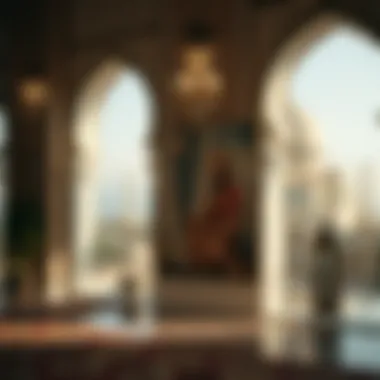Exploring Eid al-Adha: Significance and Traditions


Intro
Eid al-Adha, or the Festival of Sacrifice, holds profound significance for millions around the globe, especially within communities tracing their roots to the Gulf region. This festival is not just a time for celebration but an opportunity for reflection, gratitude, and community bonding. Each year, it commemorates the willingness of Ibrahim (Abraham) to sacrifice his son in obedience to God, marking the essence of piety and submission in Islam.
As one delves deeper, it becomes clear that Eid al-Adha is layered with a rich tapestry of traditions and practices that vary by region, culture, and individual preference. Beyond its religious undertones, this festival also has a tangible impact on economies and social structures, influencing local customs and practices. By examining the various dimensions of Eid al-Adha, readers can garner a comprehensive understanding of its relevance in both historical and modern contexts.
In what follows, this article will outline the religious significance, explore the myriad of traditions attached to this festival, and reflect upon how contemporary society observes these age-old customs. As we embark on this enlightening journey, prepare to uncover the multitude of ways that Eid al-Adha resonates within communities of diverse backgrounds and beliefs.
Stay tuned, as we unveil the intricate dynamics of this meaningful celebration.
Historical Context of Eid al-Adha
Understanding the historical context of Eid al-Adha sheds light on the depth of its significance and the rich tapestry of traditions associated with it. This section not only provides an anchor for the practices of today but also highlights how the backdrop of history shapes this vibrant celebration. The critical elements here involve the religious foundations, which establish a profound connection between believers and the act of sacrifice. The essence of Eid al-Adha isn’t merely in the festivity; it's rooted deeply in a narrative that intertwines faith, generosity, and community spirit.
Origins and Religious Foundations
The origins of Eid al-Adha trace back to pivotal moments in the Islamic tradition, specifically during the time of the Prophet Ibrahim, known as Abraham in Judeo-Christian narratives. The core story revolves around Ibrahim's unwavering faith in Allah and the test that was put before him—sacrificing his son. This tale, prevalent among various cultures, transcends time and places significant importance within the context of Islam. The act of sacrifice symbolizes surrender and submission to divine will.
The religious foundations of this celebration can be primarily seen in the Quran, where Ibrahim's devotion is acknowledged as a testament to faith. The celebration marks the culmination of Hajj, the pilgrimage that many Muslims undertake, solidifying the connection between personal sacrifice, obedience, and communal gathering. It fosters a sense of belonging among practitioners worldwide, drawing them together in reverence and celebration.
"Eid al-Adha is not just about the sacrifice of an animal; it is a celebration of life, faith, and community."
Evolution of Traditions
As centuries rolled by, the traditions surrounding Eid al-Adha evolved, adapting to cultural nuances while retaining their core religious significance. In the initial days, the festival was marked by simple communal prayers and sacrifices, reflecting the nomadic lifestyle of many early practitioners. However, as communities became more settled, additional customs emerged, intertwining local practices with the core celebrations.
For instance, in various regions, family gatherings during Eid al-Adha are seen as a vital part of the festival. People often don new clothes and prepare sumptuous feasts to share with family and friends. In South Asian cultures, the festivals are characterized by the preparation of delightful delicacies, where the aroma of biryani and kebabs fills the air, inviting everyone to partake.
In Middle Eastern countries, the tradition of sharing the sacrifice's meat with less fortunate communities has stood the test of time, reinforcing the concept of charity and communal solidarity. This evolution of traditions is a testament to how deeply rooted practices can adapt to modern society while still honoring their historical genesis.
Through delving into both the origins and the evolving nature of celebrations, one gains a rich perspective on Eid al-Adha. This festival encapsulates a journey from individual obedience to a collective expression of faith and generosity, mingling the historical with the contemporary practices that define its celebration today.
Theological Significance
The theological dimensions of Eid al-Adha are profound, cementing its place not just as a festive occasion but as a significant moment of reflection and commitment within Islamic faith. This celebration is a testament to the values of obedience, sacrifice, and community, reminding the faithful of the core principles that underpin the religion. It serves as a bridge connecting historical events to contemporary practices, making it relevant for both seasoned practitioners and those newly engaging with Islam.
Understanding Sacrifice in Islam
Sacrifice in Islam goes beyond the physical act of offering an animal for Qurbani. It encapsulates a broader narrative about submission, faithfulness, and selflessness. The practice is rooted in the story of the Prophet Ibrahim, whose unwavering dedication to God's command exemplifies the essence of sacrifice. The act of sacrificing during Eid al-Adha symbolizes not just the relinquishing of material wealth but also signifies let go of one's ego and desires in favor of higher spiritual aspirations.
This is where the community comes in. Eid al-Adha emphasizes collective participation in sacrifice, fostering a spirit of togetherness and empathy among individuals.
Moreover, the sacrifice of an animal serves a dual purpose:
- Celebration of faith: It reaffirms belief in God’s goodness and provision.
- Gratitude: It acts as a reminder for individuals to be thankful for what they have, placing less importance on material possessions.
Through this lens, the theological significance of Eid al-Adha is not just about the act itself but the intangible bond it creates among members of the community as they share in the blessings that come from their collective sacrifices.
Lessons from the Story of Ibrahim
The narrative of Ibrahim, known in English as Abraham, is crux of meaning during Eid al-Adha. His readiness to sacrifice his son Isma'il epitomizes absolute faith and trust in God's plan. For many, this story instills lessons that resonate deeply in the modern age:
- Faith in Adversity: Much like Ibrahim, adherents are reminded to maintain a strong faith, even when faced with personal trials.
- Compassion and Charity: The act of sharing the meat from Qurbani with those less fortunate reinforces the importance of charity, illuminating a path toward social responsibility.
- Community Over Individual: Ibrahim’s sacrifice was not just personal; it carried implications for his community, emphasizing that personal actions can strengthen collective bonds.
"The sacrifice of Ibrahim teaches us that true faith often requires us to let go of what we hold dear for a greater cause."
These lessons transcend the specific festival of Eid al-Adha, making it a relevant discussion point for contemporary socio-religious dialogues. The story invites individuals to reflect on their personal sacrifices, communal responsibilities, and the broader narrative of faith that unites them. Eid al-Adha, deeply rooted in these theological reflections, evolves as a dynamic symbol of resilience, compassion, and shared human experience.


Pre-Eid Preparations
The period leading up to Eid al-Adha is critical as it sets the stage for the festive celebrations to come. Pre-Eid preparations encompass a variety of tasks that hold significant importance not only for spiritual readiness but also for financial and logistical planning. In many cultures, these preparations symbolize the transition from a customary pace of life to the exuberance of Eid, blending both the sacred and the mundane.
Financial Planning and Budgeting
Financial planning is an essential component of the Pre-Eid preparations. This involves creating a budget that addresses various aspects of the upcoming festivities, like purchasing sacrificial animals for Qurbani, gifts for family and friends, and food for communal feasts.
Many individuals start this financial commitment well in advance, saving money or reallocating funds to accommodate their Eid expenses. Some families choose to set aside a specific portion of their monthly income for the month of Ramadan leading into Eid. This kind of advance planning helps in mitigating the financial strain that often comes with holiday expenditures. Here's a simple structure for a financial strategy:
- Identify Likely Expenses:
- Create a Budget:
- Monitor and Adjust:
- Sacrifice costs
- Grocery shopping for meals
- Clothing and accessories
- Gifts for children and relatives
- List income sources
- Allocate funds for each category
- Factor in a buffer for unexpected expenses
- Keep track of spending
- Make adjustments if necessary, ensuring to stay within the budget
Incorporating these financial strategies can lead to a smoother, more enjoyable Eid experience without the inevitable worry over finances.
Shopping for Eid Needs
Shopping for Eid is a tradition in many cultures, with its own significance and excitement that builds anticipation. This phase is not merely about purchasing items; it also engages individuals in a communal process of preparation—visiting markets, interacting with local vendors, and sharing festive spirits with fellow shoppers.
During this period, families often prepare lists that include:
- Traditional Clothing:
- Food Essentials:
- Gifts:
- Decorations:
- New garments for prayer and celebrations are an integral part of the rituals
- Ingredients for traditional dishes, sweet treats, and snacks to share with guests
- Tokens of affection for family, especially children, reflecting the spirit of giving during Eid
- Festive decor to embellish homes and create an inviting atmosphere
Mobilizing this kind of shopping experience brings families closer, enabling them to not just prepare for the festival, but weave a tapestry of expectations, traditions, and shared cultural heritage.
"Eid is a reminder of shared responsibility, unity, and the strength of community ties."
For more insights on Eid al-Adha financial planning, you can explore resources like Investopedia and NerdWallet.
To learn more about the traditions associated with Eid al-Adha, visit Britannica.
Eid al-Adha Rituals
Eid al-Adha is steeped in rituals that reflect the essence of the holiday—sacrifice, gratitude, and community. These rituals serve as an expression of faith and provide a means to strengthen social bonds among individuals and families. The observances during this festival not only honor the religious significance but also manifest in unique cultural practices that vary among different regions.
Prayer and Community Gathering
One of the most revered aspects of Eid al-Adha is the communal prayers that take place in mosques and open areas. This gathering is not merely a routine; it represents unity, drawing people from various walks of life together under one roof—or the vastness of the sky, in many instances. On the morning of Eid, after a ritual purificatory bath, families adorn themselves in new or their best clothes, contributing to a sense of festivity. The act of praying together transcends individual experiences, marking a collective celebration of faith and devotion to Allah.
The prayer itself carries a special structure, beginning with a sermon known as the khutbah, emphasizing the values of sacrifice and charity. It reminds attendees of their responsibilities to one another, making it clear that while individual devotions are vital, the strength and observance of community cannot be overstated.
The Act of Qurbani
This aspect of Eid al-Adha, the act of Qurbani, is pivotal to the festival, symbolizing the profound act of sacrifice. It involves the ritual slaughter of livestock, which is not just about the physical act but about the spiritual significance behind it. For many, Qurbani offers a way to emulate Prophet Ibrahim's (Abraham) profound act of faith in obeying God's command.
Types of Animals Used
Typically, the animals designated for Qurbani are sheep, goats, cattle, or camels. The selection of these animals is steeped in tradition; for instance, sheep are particularly popular due to their relative affordability and the ease with which they can be handled. Cattle, on the other hand, involve a higher cost but also yield more meat, making them an appealing choice for larger families or communities wanting to maximize benefit.


Each animal chosen carries its own significance and strikes an emotional chord with those involved. The act of slaughter must be conducted with the utmost respect and care, ensuring it aligns with Islamic guidelines. This reinforces not only the sanctity of life but also the importance of compassion in the process.
Distribution of Meat
Post-slaughter, the distribution of meat plays a crucial role in the festivities of Eid al-Adha. The meat is typically partitioned into three shares: one-third is reserved for the family, another third is given to friends and relatives, and the final third is donated to those in need. This practice emphasizes the values of charity and community support intrinsic to Islam.
It illustrates the significance of sharing and ensuring that even the less fortunate partake in the blessings of Eid. The distribution can also strengthen community ties, as families come together to assist those who might not otherwise partake in the feasts of the occasion.
Cultural Variations
Cultural variations of Eid al-Adha exhibit a vibrant tapestry of practices and customs, illustrating how a singular religious event can take on vastly different expressions across the globe. Understanding these variations enriches the overall narrative of the festival, revealing not just the core themes of sacrifice and community, but also how local history, geography, and cultural influences shape unique observances. This exploration is beneficial, particularly for stakeholders like investors, homebuyers, and property managers, who could engage with communities through these diverse traditions. The economic implications tied to these cultural expressions can also guide business decisions, showing that cultural sensitivity can yield profitable opportunities.
Eid Traditions in the Middle East
In the Middle East, Eid al-Adha is traditionally marked by grandeur, with celebrations beginning after the morning prayers. The emphasis here is not only on the religious practices but also on communal unity. Families don their finest clothes, often new, symbolizing renewal and respect for the occasion. The practice of Qurbani, or the ritual sacrifice, usually involves goat, sheep, or camel, echoing the historical context of Ibrahim’s devotion.
After the sacrifice, families gather for communal feasts, where large platters of delicacies are shared. It’s interesting to note that each country adds its own local flavors to the traditional dishes—think spiced kabobs in Turkey or luscious biryanis in the Gulf States. These shared meals serve as a potent reminder of fellowship and generosity, traits deeply woven into the fabric of Middle Eastern culture. Moreover, the acts of giving, whether in the form of sharing meat with the less fortunate or donations to local charities, emphasize the spirit of altruism that pervades the observance.
"The joy in giving, coupled with the warmth of being together with family and friends, underscores the true essence of Eid al-Adha for many in this region."
Celebrations in South Asian Communities
In South Asian communities, Eid al-Adha resonates with a rich blend of tradition and vibrancy, often embodying the essence of community spirit. The celebration here is not just confined to family gatherings but extends into public festivities, where joyous congregations can be seen in parks and community centers. People are known to exchange greetings like "Eid Mubarak!" which translates to "Blessed Eid!" before promptly diving into festivities.
The culinary aspect is particularly noteworthy, with countless varieties of savory and sweet delicacies prepared. Biryani, kebabs, and sweets like sheer khurma are staples that flow abundantly during this time, illustrating both cultural pride and hospitality. Furthermore, many South Asian families organize communal prayers in large mosques or open grounds, often attracting thousands of worshippers; the sight of diverse cultures coming together to pray is nothing short of a spectacle.
It's also essential to point out how in South Asian countries like Pakistan and India, the day holds a profound socio-economic significance. The practice of Qurbani contributes economically to livestock farmers and local markets, supporting agricultural sectors vital for the economy. Hence, every celebration resonates with religious, social, and economic implications, linking back to the central theme of sacrifice and generosity that Eid al-Adha encapsulates.
Post-Eid Reflections
After the curtains close on the festive celebrations of Eid al-Adha, a moment for reflection emerges, allowing individuals and communities to pause and consider the completed rituals and their broader implications. This period is not merely an end to the celebrations; it is a pivotal juncture for reconnecting with the essence of the festival and its teachings.
Charity and Giving Back
One of the most profound aspects of Eid al-Adha is the emphasis on charity and giving back to the community. The act of Qurbani, or the sacrificial offering of animals, serves to remind participants of their responsibility towards those less fortunate. The meat from the animal is traditionally distributed among family members, friends, and the needy, reinforcing the ties that bind a community together.
- Encouraging Generosity: This act serves as a catalyst for generosity, developing a mindset that prioritizes compassion and empathy towards others.
- Community Support Networks: Many local charities and organizations rely on the surplus generated during Eid to support their initiatives, fostering close-knit support systems.
Donations during this period can take on a variety of forms including food, money, or time, creating a swell of goodwill that flows well beyond the festival itself. Individuals are prompted to assess their commitment to charity not just during Eid, but as an essential element of their everyday lives.
Cultural Legacy and Modern Observations
The cultural legacy of Eid al-Adha intertwines traditional practices with modern interpretations, reflecting the evolution of society and its values over time. This introspection post-Eid allows communities to consider how they honor their roots while adapting to contemporary influences.
- Tradition Meets Modernity: In many urban areas, the traditional rituals are increasingly complemented by modern forms of celebration, such as community events, online campaigns for charity, and social media outreach, illustrating how the festival can evolve.
- Global Connections: Eid celebrations have transcended geographical boundaries, with various communities worldwide contributing to and sharing their experiences of the festival, highlighting a collective cultural heritage that is both diverse and unified.
Reflecting on the legacy of Eid al-Adha also urges individuals to consider their own roles and contributions in shaping this timeless festival for future generations. It poses questions regarding how traditions should be preserved and possibly transformed while maintaining their essence.
"Eid al-Adha does not just mark a calendar day; it invites us to become part of an ongoing story of faith, charity, and community, challenging us to stretch the boundaries of our engagement."
Economic Impact of Eid al-Adha
Eid al-Adha is not only a time for spiritual reflection and familial connections; it also carries significant economic implications. As communities come together to observe this important occasion, the resulting activities stimulate local economies and create opportunities for various sectors. The festival impacts everything from retail sales to travel patterns, demonstrating how intertwined cultural observance and economic vitality can be.
Boost to Local Businesses
The preparations for Eid al-Adha catalyze a flurry of commercial activity. During the weeks leading up to the holiday, local markets transform into bustling hubs where merchants showcase a variety of products, particularly fresh meats, clothing, and traditional sweets. People often increase their spending during this time, leading to higher sales for many local businesses.
- Grocery stores stock up on specialty items that families seek for their celebrations. This includes lamb and other meat for Qurbani, traditional sweets like baklava, and new clothes for family members.
- Tailors and dressmakers experience an upsurge in demand, as families often buy or create new outfits for the holiday. The art of tailoring not only supports artisans but also reflects cultural heritage.
- Additionally, restaurants often introduce special menus featuring traditional dishes to cater to the festive spirit. These establishments benefit from the influx of diners seeking to enjoy communal meals with family and friends.


Through these dynamics, local economies see a noticeable boost as shopping habits shift, encouraging a spirit of community and generosity.
Travel and Tourism Trends
Eid al-Adha also influences travel, with many families making plans to visit relatives or travel to pilgrimage sites. This surge in travel can lead to significant revenue for various sectors, including airlines, hotels, and transport services.
- Hotels in regions popular for Eid celebrations often report full bookings well in advance. Families from around the world may converge on cities noted for their festivities, stimulating local tourism.
- Moreover, travel agencies might offer package deals that cater specifically to the Eid period, including flights to predominantly Muslim countries where the celebration is at its height.
- Transport companies, from buses to taxis, observe increased business, as individuals rely on public transport for gatherings and celebrations.
"Eid al-Adha does more than just uplift spirits; it propels local economies in ways that are hard to measure yet easy to see when a community thrives during this religious festival."
Understanding the economic impact of Eid al-Adha can give investors and property managers valuable insights. Recognizing these seasonal patterns can guide decisions about business expansions, property investments, and community support strategies that align with cultural observances. The festival's significance reaches far beyond its spiritual core, showing how deeply culture and economy are entwined.
Environmental Considerations
Eid al-Adha brings forth a tapestry of cultural and religious richness, yet it also casts a shadow of environmental challenges that need addressing. As communities embrace this festival with enthusiasm, it's vital to navigate the balance between celebration and ecological stewardship. There’s more to Eid than meets the eye, especially in how its observances can coalesce with sustainability efforts and waste management initiatives. Taking a comprehensive look at these aspects not only informs our practices during this cherished time but also sets a precedent for future generations.
Sustainability Practices in Qurbani
The act of Qurbani, or sacrifice, is at the heart of Eid al-Adha. Traditionally, animals such as sheep, goats, cows, and camels are sacrificed, with the meat divided among family, friends, and the less fortunate. However, this pivotal ritual also presents an opportunity to champion sustainable practices.
Here are some points to ponder on sustainability during Qurbani:
- Choosing Local Suppliers: Supporting local farms reduces carbon footprint. Buying locally sourced livestock cuts down on transport emissions and bolsters community economies.
- Ethical Treatment of Animals: Ensuring humane practices in animal husbandry is crucial. Opting for farms that adhere to ethical standards promotes a culture of compassion and responsibility.
- Mindful Consumption: Encouraging families to practice portion control and distribute meat judiciously can minimize food waste. It promotes sharing and helps meet the nutritional needs of various community members.
- Reusing By-Products: Utilizing the by-products of the sacrificed animal—like skin, bones, and fat—can lead to additional sustainable practices. This not only respects the sacrifice but also provides materials for various culinary and commercial uses.
Ultimately, rethinking traditional practices with a focus on sustainability can enhance the experience of Qurbani and influence positive environmental change.
Waste Management During Festivities
With any celebration, the potential for waste generation is significant. Eid al-Adha is no exception, as festivities can lead to excess waste if not managed properly. A strategic approach to waste management is essential to ensure that the celebration does not come at the cost of our environment.
To effectively manage waste during Eid al-Adha, consider these strategies:
- Community Clean-Up Initiatives: Promoting neighborhood clean-up events post-celebration can be beneficial. Engaging community members in tidying up public spaces fosters shared responsibility and unity.
- Reducing Single-Use Plastics: Encouraging the use of reusable utensils, plates, and containers can drastically reduce the disposal of single-use plastics, which are often found in abundance during celebrations.
- Organizing Donation Drives: Unused food can often go to waste. Setting up systems for food donations to local shelters ensures that excess food serves those in need instead of ending up in landfills.
- Education and Awareness: Raising awareness about responsible disposal practices among attendees is paramount. Information sessions and social media campaigns can equip families to take steps toward a sustainable Eid celebration.
"If each household made an effort to reduce waste during Eid al-Adha, we could significantly lessen our impact on the environment, fostering a spirit of communal care."
For more insights on sustainable practices, check out environmental sustainability resources and waste management tips.
Social Cohesion and Community Building
Eid al-Adha is more than just a religious observance; it serves as a platform that reinforces social cohesion and community building. During this festive period, individuals and families come together, creating an atmosphere of unity and support that has a significant impact on both local communities and individuals’ personal connections. The essence of social cohesion lies in fostering relationships and establishing a sense of belonging, and Eid al-Adha provides a framework for these essential elements to flourish.
Strengthening Family Bonds
One of the most vital aspects of Eid al-Adha is its capacity to strengthen family ties. Families often gather to share meals, participate in prayers, and partake in rituals that celebrate the act of sacrifice. This deepens their bonds through shared experiences and communal activities. The rituals of the day provide opportunities for family members to reconnect, especially in a world where individuals often lead busy lives.
Key Benefits of Strengthening Family Bonds During Eid:
- Reinforced Values: Family gatherings during Eid enhance the transmission of cultural and moral values to younger generations, ensuring that traditions continue to be honored.
- Support Systems: Strengthened family bonds create a robust support system, particularly essential during challenging times.
- Collective Joy: Celebrating Eid together allows families to share in the joy and festivities, which fosters a sense of happiness and positivity.
For families of diverse backgrounds, the day is marked by practices such as joint prayers and shared meals, making it an important time for strengthening relationships that might otherwise go neglected.
Community Involvement and Support
Beyond the family unit, Eid al-Adha emphasizes community involvement. The practice of Qurbani, or the ritual sacrifice, extends beyond personal allocation of resources, as many choose to share their blessings with those in need. This collective generosity helps in nurturing community ties and aids in spreading goodwill. It teaches invaluable lessons about empathy, compassion, and shared responsibility.
Elements of Community Involvement During Eid:
- Charitable Giving: The distribution of meat from Qurbani often benefits the less fortunate, reiterating the principle of community support in Islam.
- Local Events: Communities frequently organize events such as communal prayers and gatherings that encourage participation and connection among residents, strengthening the social fabric.
- Networking Opportunities: Such gatherings can also serve as a platform for individuals to network, promoting unity and understanding across communities with differing backgrounds.
Community involvement during Eid fosters a culture where giving back becomes a shared responsibility. Engaging in charitable acts during this time strengthens not just individual bonds, but also promotes a sense of togetherness throughout the entire community.
"Eid al-Adha’s true spirit lies in its ability to unify people, fostering relationships that go beyond mere festive traditions and create lasting social ties."
The essence of Eid al-Adha transcends beyond personal joy; it is a reminder of the importance of collective memory and shared experiences, showcasing how a celebration rooted in sacrifice can weave stronger social bonds and invigorate community spirit. Through fostering cohesion, the festival serves as a vital reminder of the importance of togetherness in an increasingly fragmented society.















